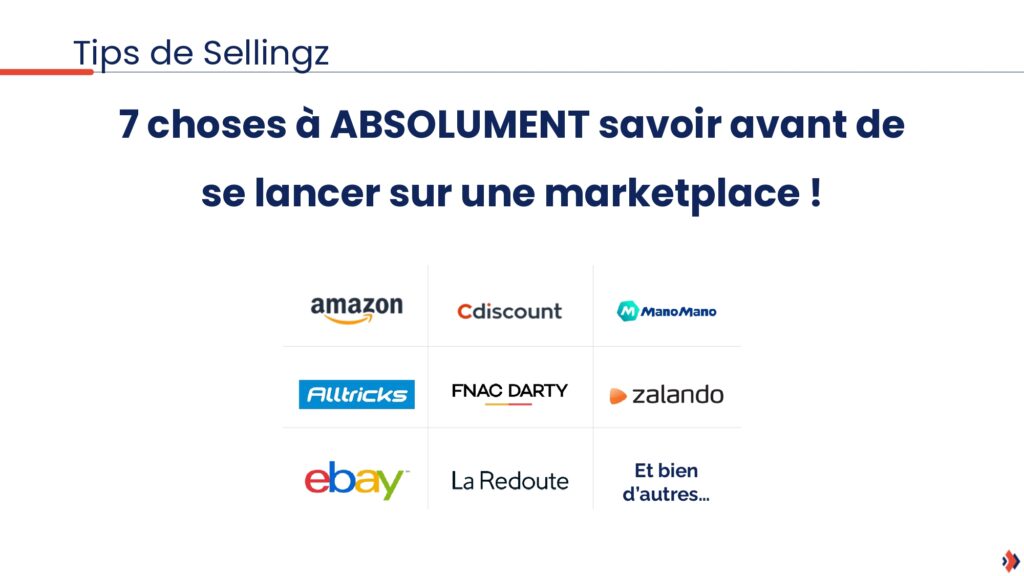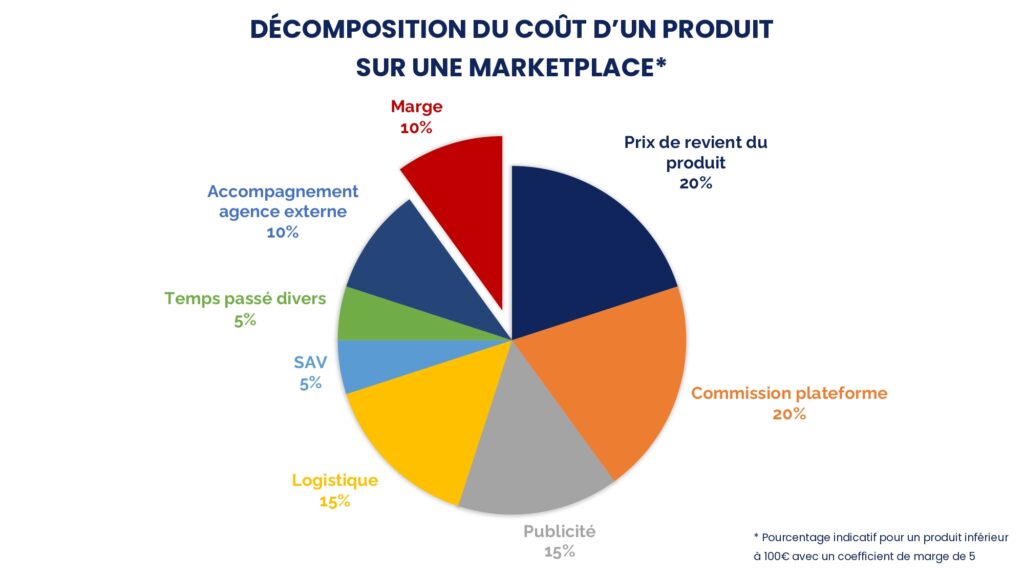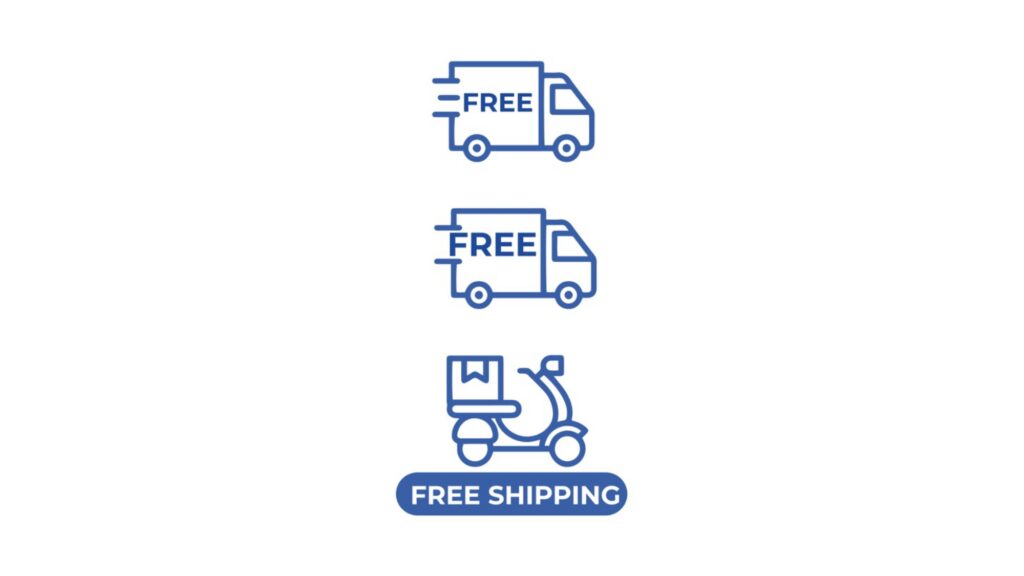Receive our news
Subscribe to our monthly newsletter

Have you decided to launch on a marketplace to reach more customers and make more sales? Great news!
However, be careful not to jump in head first. Not only do marketplaces not work like a traditional e-commerce site. But Amazon, Cdiscount, La Redoute or Zalando customers also expect an optimal shopping experience when buying on these platforms!
Selling on a marketplace therefore requires knowledge of the rules and good preparation.
To help you, our experts Sellingz have listed the 7 things you absolutely must know before launching on a marketplace... to really develop sales and increase your turnover in complete serenity!
At Sellingz, our experts recommend a minimum margin coefficient of 5 between the cost price of the product and the final sales price for products with a sales price including VAT of less than €35.
The minimum coefficient should be increased if your product is heavy or bulky. Conversely, it should be lowered if the product is light and small, and if its selling price including VAT is higher than 40 €, as the value margin makes it easier to cover costs.
Indeed, selling on Amazon, or on any other marketplace, involves certain incompressible expenses such as :
You should also take into account the time spent by your staff on :
And, potentially, the costs of a specialist marketplace agency such as Sellingz.

The products with the best margin in e-commerce have a price above €50 and weigh less than 500g (typical examples: glasses, beauty products).
Indeed, the selling price is high enough to finance what needs to be financed. And the package is light enough and small enough to reduce shipping costs!
Launching as a reseller on a marketplace requires defining a short, medium and long term strategy to last.
Indeed, putting a product sheet online is not enough to sell well on a marketplace! You need to anticipate any problems that may arise afterwards, particularly in terms of logistics, sales administration, customer returns, stock management, etc.
Anticipating with an effective marketplace strategy is therefore the best way to achieve your goals (and will avoid a possible seller account closure due to logistical or user experience issues!)
Objectives provide a vision of where you want to go and how to get there. Like any strategy, it is important to analyse the results as you go along in order to readjust what needs to be readjusted and adapt your strategy.
Do you want to launch on a marketplace?
87% of French people look at customer reviews before buying (source e-marketing.fr).
Ratings and comments are therefore at the heart of the strategy of marketplaces and e-tailers. As a result, a bad customer experience can lead to the closure of a pro-seller account!
In order to avoid too many returns (due to a defective product for example), have impeccable logistics. Also be responsive! You must be able to respond quickly to questions left by users on the product sheets or in the back office.
User experience is taken for granted by consumers who are more critical than positive. So put all the chances on your side by offering an excellent customer relationship... and limit the number of bad reviews that would penalise your brand on the marketplaces!

Customer ratings and reviews are a gold mine for continuous improvement of your products, product sheets and processes! So take the time toanalyse all the customercomments on the products and also on the delivery.
Good stock management is another important point when selling on a marketplace. Indeed, the more available your products are, the higher they will be in the search engines!
However, be sure to keep your stocks up to date. An order placed when the product is no longer available would result in a cancellation of the sale... and could result in your brand being permanently excluded from the platform if the volume of these problems increases.
Furthermore, if you have opted for remote management of your stocks (Amazon FBA, Cdiscount Fulfillment, ZFS), as long as your products are doing well, the price of storage by the platform remains reasonable. But if your products are not selling well (due to poor visibility in search results, for example), the bill may be higher!
Finally, note that to avoid the destruction of products, Amazon can return your unsold products... at your expense!
Make sure you have enough stock from the start to ensure sales in case of high demand. Remember, if a product is no longer available, you lose visibility in search engines.
And much of the work you have done beforehand will have to be redone!
One of the main motivations of a customer buying on a marketplace is the delivery time. When buying on Amazon, La Redoute, Zalando or Cdiscount, customers will be attracted and will prefer a product delivered in 24/48 hours!
Moreover, if you do not respect the delivery time set in your space, you run the risk of having your pro seller account closed by the platform!
Before launching yourself on a marketplace, check beforehand that your logistics are capable of meeting very short delivery times. And this is true even for orders of several products!
Take the time to read the specifications carefully and analyse your existing logistics processes. We can never say it enough: anticipating is the best way to avoid penalties and problems due to long delivery times!

FBA Amazon (Fulfillment By Amazon), Cdiscount Fulfillment or Zalando Fulfillment Solutions (ZFS) are practical solutions for offloading your stocks and relieving you of the delivery of the sales unit, thus guaranteeing optimal delivery times to your customers.
You entrust your stocks to the marketplaces, which charge you for storing the products in their warehouses. They take care of sending your orders to your customers themselves and managing returns. Simple, efficient and without risk for your brand!
Would you like to know more about the possibilities in stock management?
It is often forgotten, but an advertising budget is essential when launching on Amazon or any other marketplace.
Why?
Simply because the algorithm only brings up products that sell. Therefore, when you launch a new product, you have to pay for advertising to make it visible in the search results and generate sales!
Advertising allows you to stand out among the many marketplace resellers already present.
At Sellingz, we estimate that the advertising investment for a product launch is around 10 to 15% of the turnover target. It can be as high as 25% for the most competitive categories such as beauty or toys.
Selling on one or more marketplaces requires daily monitoring of stocks, invoicing, sales prices, etc. This is why our experts strongly recommend the use of IT tools adapted to online sales.
Using a marketplace feed aggregator such as Lengow or Shopping Feed allows you to centralise the information in one place. It is then easier and faster to adjust a price from one platform to another. This is a welcome time-saver, especially in times of high raw material prices!
What's more, the more business you do, the more time-consuming platform management will become.Automating tasks will be essential to avoid wasting unnecessary time for your teams.
At Sellingz, we work with Saivingz tools, an AI solution that allows you to manage customer relations by automating part of the customer relationship. A two-in-one tool perfectly adapted to the management of your pro accounts on marketplaces!
Don't hesitate to ask our experts for advice on a marketplace business plan that will help you reach your goals quickly!